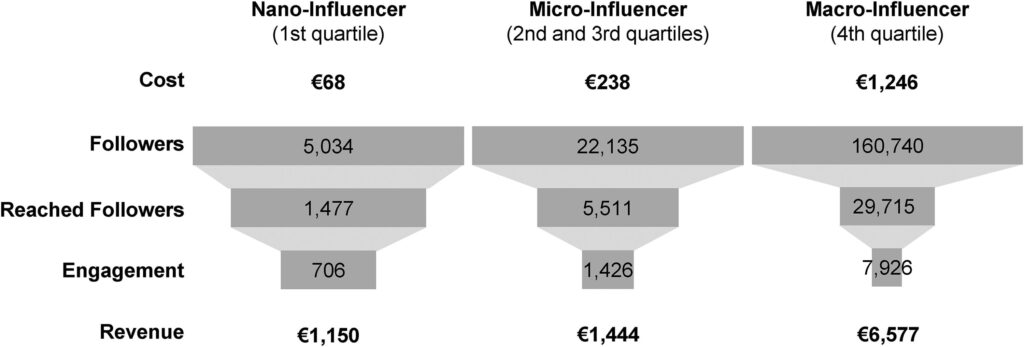In a recent article, I dived into the world of “Influencer Marketing for Startups” where I unfolded the concept and explored how SaaS startups could leverage influencers to stand out in a crowded market. The journey didn’t stop there. Driven by curiosity and a thirst for deeper understanding, I continued to explore the influencer marketing universe, engaging in conversations with various professionals in the field.
During this exploration, I stumbled upon a recent research paper that caught my attention. Published in November 2023 by Maximilian Beichert, Andreas Bayerl, Jacob Goldenberg, and Andreas Lanz, this study offers fresh insights into the influencer marketing strategy, specifically for direct-to-consumer (DTC) firms. The paper delves into the critical question of whether targeting low- or high-followership influencers generates more immediate revenue for direct-to-consumer firms.

What makes this study particularly intriguing is its focus on empirical data and field studies, providing robust evidence to support its findings. The authors have meticulously analyzed secondary sales data of over 1.8 million purchases and conducted full-fledged field studies involving hundreds of paid influencer endorsements. Their findings challenge the prevailing wisdom in influencer marketing, offering valuable lessons for businesses of all sizes, especially small businesses and startups looking to maximize their marketing ROI.
In this article, I’ll try to summarize these findings and adapt them into an easy marketing strategy for small businesses!
The Power of Low-Followership Influencers
When we think about influencer marketing, it’s easy to fall into the trap of equating influence with a large number of followers. The common belief is that more followers mean more reach and, consequently, more impact. However, the research challenges this notion and sheds light on the unmatched power of low-followership influencers.

Analyzing the influencer marketing funnel, from follower counts on social platforms to the engagement rates and actual revenue generated, the study’s most striking findings is that influencers with a smaller follower base can offer significantly higher returns on investment (ROI) compared to their high-followership counterparts.
Why? The answer lies in engagement. Unlike high-followership influencers, who may struggle to maintain a personal connection with their audience due to sheer volume, low-followership influencers often enjoy a closer, more authentic relationship with their followers. This intimacy translates into higher engagement rates, as followers are more likely to interact with content that feels personal and genuine. The study supports this, showing a clear correlation between lower followership levels and increased engagement, ultimately leading to better ROI.
Key findings for small businesses
Small businesses often navigate through a maze of decisions, trying to figure out where to invest their limited marketing resources for the best return. Here are the key takeaways from the study, tailored for small businesses looking to make a big impact:
1. Value of low-followership influencers
As explained in the previous part, influencers with fewer followers can significantly outperform those with larger followings in terms of ROI. It means that investing in partnerships with low-followership influencers—those who have a smaller but highly engaged audience—can be more cost-effective and yield better results.
2. Engagement over followership
Prioritize influencers who have a strong connection with their audience, regardless of the size of their followership. Engaged followers are more likely to trust the influencer’s recommendations, leading to higher conversion rates. Small businesses should focus on how well an influencer resonates with their audience, rather than how many people they can reach.
3. Cost-effectiveness of nano and micro-influencers
Nano and micro-influencers typically command lower fees than their more famous counterparts, making them an ideal choice for small businesses with limited marketing budgets:

Their higher engagement rates can lead to a better ROI, making each dollar spent more effective.
4. Authenticity and trust
Low-followership influencers often maintain a level of authenticity that is sometimes lost as influencers grow their audience. For small businesses, partnering with influencers who genuinely believe in their product or service can lead to more authentic endorsements. This authenticity fosters trust among the influencer’s audience, which is invaluable for small businesses looking to build their brand and customer base.
5. Strategic alignment
It’s not just about finding any influencer with a high engagement rate; it’s about finding the right influencer whose audience aligns with the business’s target market. Small businesses should invest time in identifying influencers who share their brand values and have an audience that matches their ideal customer profile.

That’s it… A big study but a major key-finding for you to exploit. I’ll be frank with you, I have not a big experience with influencer marketing. But the funnel comparison in the previous part is quite interesting. Small (and probably bigger) companies should know that ratio and don’t pick only the biggest influencers. I’ll keep that in mind. Won’t you?

Comments